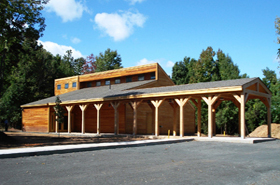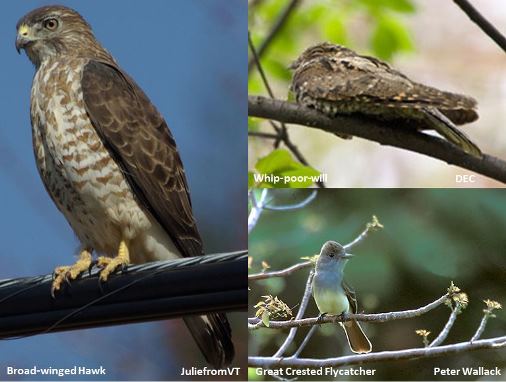Clay Pit Ponds State Park Preserve

2351 Veterans Road West
Staten Island, NY 10309
- General Information: (718) 967-1976

Clay Pit Ponds State Park Preserve is a 265-acre nature preserve near the southwest shore of Staten Island. It contains a variety of unique habitats, such as wetlands, ponds, sand barrens, spring-fed streams and woodlands. The preserve is managed to retain its unique ecology and to provide educational and recreational opportunities for people of all ages. Evidences of the Leni Lenape Indians, European settlers and the Free Blacks of Sandy Ground provide a rich cultural history. Educational programs, such as nature walks, pond ecology, birdwatching and tree and flower identification, are offered, as are many activities geared to school children. School and group programs are also welcome by advance registration. In addition, visitors may picnic or hike on designated trails. Horseback riding is also permitted on over 5 miles of bridle paths. Please note that horses are not available to rent.
The Nature Interpretive Center at Clay Pit Ponds is open to the public for free programming and drop in. This fully accessible building features interpretive displays of the history of the park and of its natural elements. The park's educational and community programs take place in the interpretive center located at 2351 Veteran's Road West Staten Island, NY 10309 Phone: (718) 605-3970
Pet Policy: No pets allowed
Hours of Operation
- Park open year-round, sunrise to sunset daily.
- The Interpretive Center is open Tuesday - Saturday 9:00 am - 4:30 pm and Sundays 12:00 pm - 4:30 pm with exhibits, classroom space, games and access to Preserve trails.
- Office Hours: 8:30 am - 5:00 pm.
Fees & Rates
Most New York State Parks charge a vehicle use fee to enter the facility. Fees vary by location and season. A list of entry fees and other park use fees is available below. For fees not listed or to verify information, please contact the park directly.
The easy-to-use Empire Pass card is $80- and your key to all-season enjoyment with unlimited day-use entry at most facilities operated by State Parks and the State Dept. of Environmental Conservation including forests, beaches, trails and more. Purchase online or contact your favorite park for more information. Learn more about our Admission Programs including the Empire Pass.
- Bus Entry Fee
- Non-Profit Buses $35
Commercial Buses $75 - Bus Fees
- Non Profit: $35
Commercial: $75 - Private Event Permit
- $30 permit fee plus donation
Maps

New! Download this park's digital map to your iOS Apple and Android device.
Highlights of Clay Pit Ponds State Park Preserve:
- Enjoy the wonderful scenery of Sharrotts Pond accessible by the White Trail. Catch a glimpse of a Great Blue Heron or Egret from the wooden overlook or just enjoy the serenity of the pond.
- Clay Pit Ponds is the only state park on Staten Island!
- Get an idea of how Clay Mining impacted this area by walking to the pavilion located behind the Park Office to see a vast ravine that was mined for its clay. The white kaolin clay mined from the pits provided raw material for bricks and terra cotta. Now the pits have filled with rainwater, natural springs, and vegetation.
What will you see? Plan your visit today!
Look and listen for these birds at our Park:
Everyone is a Steward: Be a Clay Pit Ponds State Park Preserve Hero!
- Know the rules and concerns for the area you'll be visiting.
- Leave rocks, plants and other natural objects as you find them.
- Respect other visitors and their experience. Avoid excessive noise.
- Share the trail. Keep to the right except to pass. When in doubt, give the other user the right of way. Warn people when you are planning to pass.
- Respect wildlife and observe from a distance.
- Protect wildlife and your food by storing rations and trash securely.
- Use extra caution when using headphones. You may not be able to hear warnings.
- Don't litter.
- Hike on established, durable trails.
For more information, please read our Trail Tips!
Ask a Naturalist!
Q: How many deer do we have here?
A: We do not have a hard number, but estimate that there are between 20 and 30 deer.
Q: What kinds of birds do we have?
A: Herons, Ducks, Turkey Vultures, Hawks, Wild Turkeys, Rock Doves, Owls, Hummingbirds, Woodpeckers, Tree and Barn Swallows, Blue Jays, American Crows, Titmice, Wrens, Thrushes, Mockingbirds, Catbirds, Red-eyed Vireos, Warblers, Cardinals, Sparrows, Blackbirds, Grackles, Orioles and Finches, just to name a few. Did you know that Clay Pit Ponds State Park Preserve is a Bird Conservation Area?
Q: What is a unique area?
A: Unique Areas are considered areas of special natural beauty, wilderness character or geological, ecological or of historical significance so that present and future generations may share their ecological, educational and recreational value. Unique areas are defined under Article 45 of the State's Environmental Conservation Law. Unique Areas are entitled to the same constitutional protection as areas within the state Forest Preserve which includes the Adirondacks. Areas so protected must remain in their natural state.
Q: How do I avoid deer ticks?
A: Stay on hiking trails, avoiding long grass and brushing against vegetation. Wear light colored clothing, long pants and long sleeved shirts. Tuck pant legs into socks. For added protection, spray the outside of clothing with a tick repellant (follow label recommendations). Carry a lint roller and roll it on your clothes often. Ticks are very difficult to see, but this method will catch them even if you can't see them. After hiking, perform a search for ticks on your clothing. As soon as possible, take a shower and perform another tick inspection.
Q: What should I do if I see a male deer with antlers?
A: Usually deer are more afraid of us than we are them. However, if it's the rutting season, male deer can be more aggressive and territorial because they're vying for mating privileges with does. Don't panic. Stop. Slowly back away and if possible, return the same way you came. If the deer snorts and starts toward you, get behind the largest tree you can and summon help as soon as possible.
Q: How do I avoid poison ivy?
A: In order to avoid Poison Ivy, one needs to know what it looks like. If you're not familiar with it, Google it, download a picture and print it out so you can carry it with you. You can catch poison ivy from any part of the plant, so learn how to identify leaves and vines. Poison Ivy is very common and grows throughout the preserve on trees and on the ground. To be on the safe side, don't brush up against or touch vegetation you're not familiar with. If you think you have come in contact with poison ivy, wash that area thoroughly with a product like Technu, which washes the poison ivy oils away.
Did You Know?
- DID YOU KNOW? American Bald Eagles have been spotted in the preserve.
- DID YOU KNOW? Over 170 species of birds have been found here.
- DID YOU KNOW? Clay Pit Ponds is home to one of New York State's rarest turtles.
Considered the most traditional state park in New York City, Clay Pit Ponds is a 265-acre nature preserve containing a variety of unique habitats, such as wetlands, ponds, sand barrens, spring-fed streams and woodlands. The park preserve's name derives from the site's abandoned clay mine pits now filled with rain and spring water. Evidence of the Leni Lenape Indians, European settlers and the Free Blacks of neighboring Sandy Ground provide a rich cultural history. Designated a Bird Conservation Area, Clay Pit Ponds boasts 180 bird species. The park preserve offers 5 miles of woodland trails, an historic working organic farm, and a nature center with a variety of programming for all ages. New York State Parks created Clay Pit Ponds State Park Preserve in 1981 with the targeted acquisition of approximately 123 acres of privately owned land, 110 acres of NYC owned land and a variety of transportation rights-of-way.

Key BCA Criteria:
- Migratory concentration site
- Diverse species concentration site
Clay Pit Ponds State Park Preserve is on the southwestern portion of Staten Island. The Bird Conservation Area (BCA) constitutes a portion of the Park Preserve. The BCA has a variety of habitats including wetlands, ponds, sand barrens, spring-fed streams and woodlands, which provide food, shelter, and breeding sites for birds and other wildlife. The Clay Pit Ponds BCA is also important because it provides a relatively large, contiguous area of forest that serves as an oasis for migratory birds. Careful evaluation of the criteria for BCA designation has shown that most of the Park Preserve qualifies as a BCA.
There are 180 species of birds that have been identified within the Clay Pit Ponds BCA. Fifty-seven species of Neotropical migratory songbirds have been observed. Forest dwelling Neotropical migrants include Broad-winged Hawk, Yellow-billed and Black-billed Cuckoos, Great Crested and Olive-sided Flycatchers, Red-eyed Vireo, Blue-gray Gnatcatcher, Wood Thrush, Veery and Swainson's Thrush. In addition, 31 species of warblers have been recorded including Palm, Bay-breasted and Wilson's Warblers. Whip-poor-will (special concern) has been confirmed as a breeder in the past and may continue to breed.
Download a copy of the BCA map.
Go Birding with the Clay Pit Ponds Bird Checklist
Tuesday, September 16, 2025 10:00 AM - 11:30 AM
Clay Pit Ponds State Park Preserve
Thursday, September 18, 2025 09:00 AM - 11:00 AM
Clay Pit Ponds State Park Preserve
Saturday, September 20, 2025 10:00 AM - 12:00 PM
Clay Pit Ponds State Park Preserve
Saturday, September 20, 2025 02:00 PM - 04:00 PM
Clay Pit Ponds State Park Preserve
Tuesday, September 23, 2025 10:00 AM - 11:30 AM
Clay Pit Ponds State Park Preserve
Amenities Information
- Amenities
- Equestrian Trails
- Hiking
- Nature Center
- Pavilions and Shelter Rentals (Accessible)
- Visitor Center (Accessible)
